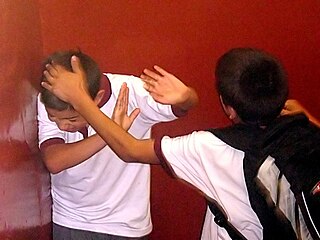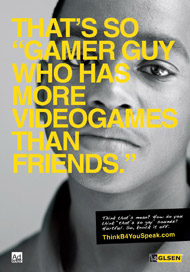
Bullying is the use of force, coercion, hurtful teasing or threat, to abuse, aggressively dominate or intimidate. The behavior is often repeated and habitual. One essential prerequisite is the perception of an imbalance of physical or social power. This imbalance distinguishes bullying from conflict. Bullying is a subcategory of aggressive behavior characterized by hostile intent, imbalance of power and repetition over a period of time.
Workplace bullying is a persistent pattern of mistreatment from others in the workplace that causes either physical or emotional harm. It can include such tactics as verbal, nonverbal, psychological, and physical abuse, as well as humiliation. This type of workplace aggression is particularly difficult because, unlike the typical school bully, workplace bullies often operate within the established rules and policies of their organization and their society. In the majority of cases, bullying in the workplace is reported as having been done by someone who has authority over the victim. However, bullies can also be peers, and subordinates. When subordinates participate in bullying this phenomenon is known as upwards bullying .The least visible segment of workplace bullying involves upwards bullying where bully- ing tactics are manipulated and applied against “the boss,” usually for strategically designed outcomes.
Internet safety, also known as online safety, cyber safety and electronic safety (e-safety), refers to the policies, practices and processes that reduce the harms to people that are enabled by the (mis)use of information technology.

School bullying, like bullying outside the school context, refers to one or more perpetrators who have greater physical strength or more social power than their victim and who repeatedly act aggressively toward their victim. Bullying can be verbal or physical. Bullying, with its ongoing character, is distinct from one-off types of peer conflict. Different types of school bullying include ongoing physical, emotional, and/or verbal aggression. Cyberbullying and sexual bullying are also types of bullying. Bullying even exists in higher education. There are warning signs that suggest that a child is being bullied, a child is acting as a bully, or a child has witnessed bullying at school.
Cyberstalking is the use of the Internet or other electronic means to stalk or harass an individual, group, or organization. It may include false accusations, defamation, slander and libel. It may also include monitoring, identity theft, threats, vandalism, solicitation for sex, doxing, or blackmail.

The Think Before You Speak campaign is a television, radio, and magazine advertising campaign launched in 2008 and developed to raise awareness of the common use of derogatory vocabulary among youth towards lesbian, gay, bisexual, transgender, queer/questioning (LGBTQ) people. It also aims to "raise awareness about the prevalence and consequences of anti-LGBTQ bias and behaviour in America's schools." As LGBTQ people have become more accepted in the mainstream culture more studies have confirmed that they are one of the most targeted groups for harassment and bullying. An "analysis of 14 years of hate crime data" by the FBI found that gays and lesbians, or those perceived to be gay, "are far more likely to be victims of a violent hate crime than any other minority group in the United States". "As Americans become more accepting of LGBT people, the most extreme elements of the anti-gay movement are digging in their heels and continuing to defame gays and lesbians with falsehoods that grow more incendiary by the day," said Mark Potok, editor of the Intelligence Report. "The leaders of this movement may deny it, but it seems clear that their demonization of gays and lesbians plays a role in fomenting the violence, hatred and bullying we're seeing." Because of their sexual orientation or gender identity/expression, nearly half of LGBTQ students have been physically assaulted at school. The campaign takes positive steps to counteract hateful and anti-gay speech that LGBTQ students experience in their daily lives in hopes to de-escalate the cycle of hate speech/harassment/bullying/physical threats and violence.

Megan Taylor Meier was an American teenager who died by suicide by hanging herself three weeks before her 14th birthday. A year later, Meier's parents prompted an investigation into the matter and her suicide was attributed to cyberbullying through the social networking website MySpace. Lori Drew, the mother of a classmate of Meier, was found guilty of cyberbullying in the 2009 case United States v. Drew. However, her conviction was overturned by the judge.
Researchers study Social media and suicide to find if a correlation exists between the two. Some research has shown that there may be a correlation.

Sexual bullying is a form of bullying or harassment in connection with a person's sex, body, sexual orientation or with sexual activity. It can be physical, verbal or emotional in nature, and occurs in various settings, including schools, workplaces, and online platforms. Sexual bullying can have serious and lasting effects on the mental and emotional well-being of victims.
Bullying and suicide are considered together when the cause of suicide is attributable to the victim having been bullied, either in person or via social media. Writers Neil Marr and Tim Field wrote about it in their 2001 book Bullycide: Death at Playtime.
Cyberstalking and cyberbullying are relatively new phenomena, but that does not mean that crimes committed through the network are not punishable under legislation drafted for that purpose. Although there are often existing laws that prohibit stalking or harassment in a general sense, legislators sometimes believe that such laws are inadequate or do not go far enough, and thus bring forward new legislation to address this perceived shortcoming. In the United States, for example, nearly every state has laws that address cyberstalking, cyberbullying, or both.
Anti-bullying legislation is a legislation enacted to help reduce and eliminate bullying. This legislation may be national or sub-national and is commonly aimed at ending bullying in schools or workplaces.
Cyberbullying or cyberharassment is a form of bullying or harassment using electronic means. Cyberbullying and cyberharassment are also known as online bullying. It has become increasingly common, especially among teenagers and adolescents, due to the communication technology advancements and young people's increased use of such technologies. Cyberbullying is when someone, typically a teenager, bullies or harasses others on the internet and other digital spaces, particularly on social media sites.

Destroying Avalon is a 2006 teen novel by Australian author Kate McCaffrey. The story follows fourteen-year-old Avalon as she moves from the country to an urban high school.

Rehtaeh Anne Parsons, was a 17-year-old Cole Harbour District High School student who attempted suicide by hanging at her home in Dartmouth, Nova Scotia, Canada, on April 4, 2013, leading to a coma and the decision to switch her life support machine off on April 7, 2013. Her death has been attributed to online distribution of photos of an alleged gang rape that occurred 17 months prior to her suicide, in November 2011. On a Facebook page set up in tribute to her daughter, Parsons' mother blamed the four boys who allegedly raped and released images of her, the subsequent constant "bullying and messaging and harassment", and the failure of the Canadian justice system, for her daughter's decision to die by suicide.
Bullying in higher education refers to the bullying of students as well as faculty and staff taking place at institutions of higher education such as colleges and universities. It is believed to be common although it has not received as much attention from researchers as bullying in some other contexts. This article focuses on bullying of students; see Bullying in academia regarding faculty and staff.
People v. Marquan M., 2014 WL 2931482 was the first case in which a US court weighed the constitutionality of criminalizing cyberbullying. In People v. Marquan M., the New York Court of Appeals struck down an Albany County law that criminalized cyberbullying, declaring its restrictions overly broad and thus in violation of the Free Speech Clause of the First Amendment.
Online child abuse is a unique form of child abuse also known as “Cyber Molestation” due to its virtual, distanced, and anonymous nature. Such abuse may not happen face-to-face, nor does it necessarily require physical contact. However, online abuse can result in negative face-to-face consequences in the form of statutory rape, forcible sexual assault, harassment, etc. In the United States, online child abuse is recognized as a form of child abuse by the National Society for the Prevention of Cruelty to Children.

Rebecca Ann Sedwick was a 12-year-old American student at Crystal Lake Middle School in Lakeland, Florida who died by suicide when she jumped off a concrete silo tower, just 1 month and 10 days before her thirteenth birthday. Investigation into her death led to a conclusion of in-person and cyberbullying contributing to the decision to take her own life. Sedwick's family later filed a lawsuit in relation to her death.







